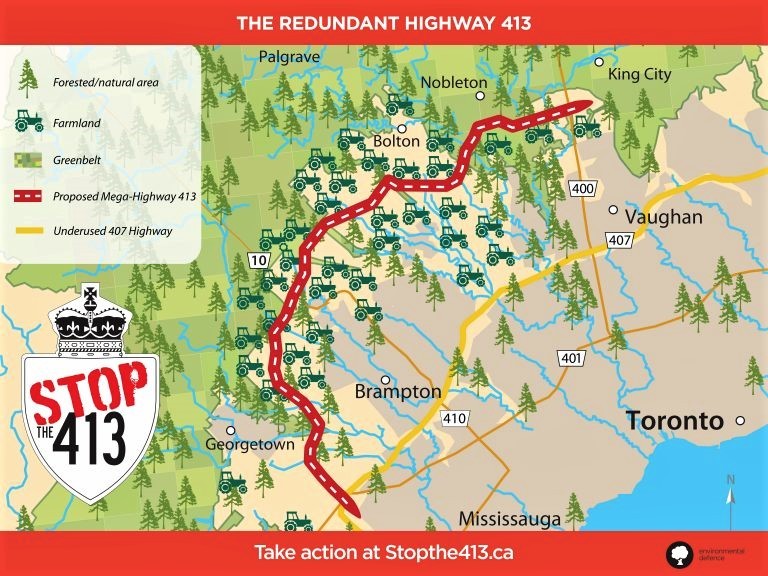
‘The project should be cancelled’ – new report by Environmental Defence takes aim at GTA West Highway
A new report by advocates against the creation of the GTA West Highway in Ontario backs up statements the City of Brampton recently made to The Pointer – plans for the new route will create more sprawl and congestion.
Environmental Defence, an organization that advocates for a safe climate, released a 19-page report Thursday morning outlining why the highway should be cancelled, showing it will create more negative impacts than benefits.
“A new 400-series highway is not the answer to ease congestion in the GTA,” the report states. “The project should be cancelled.”
On August 7, the provincial government announced it had selected its preferred route for the 413, GTA West Highway.
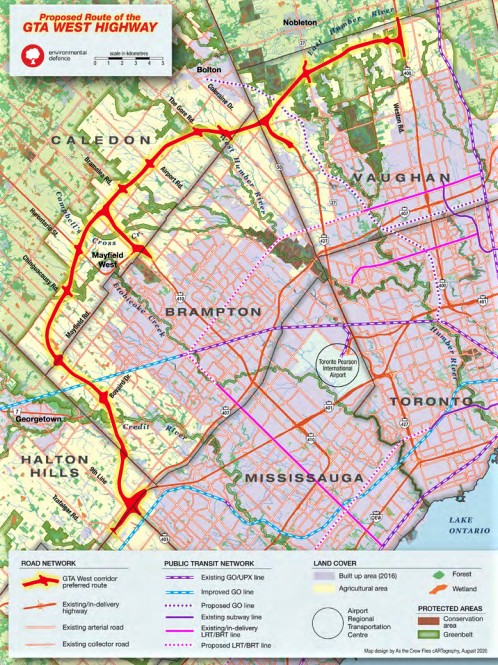
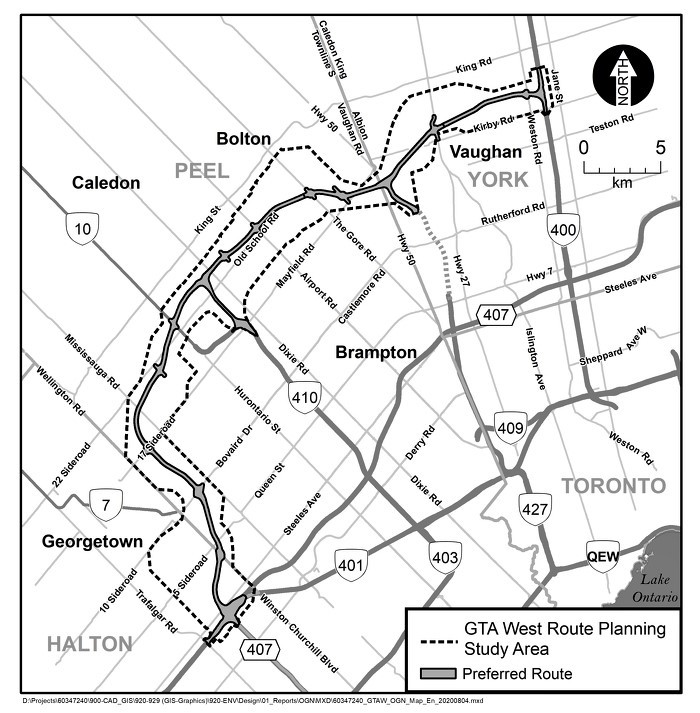
The province's recently announced route for the 413 Highway
Findings of an expert panel that led to the original cancellation of the project under the previous Liberal government have not been heeded under the PC government, the report says. In 2018, an advisory panel found it “would deliver few benefits, and could not be justified.”
The report from Environmental Defence estimates the project will cost upwards of $6 billion.
Keith Brooks, Programs Director with Environmental Defence, was asked if the federal government could intervene. He told The Pointer it was unlikely to happen. While the federal government has an Impact Assessment Act, legislation designed to ensure major projects are safe and protect the environment, which allows the examination of highway proposals, the GTA West doesn’t qualify for an assessment because it’s not long enough, Brooks said. He also doesn't believe the project is in violation of the federal climate change policy.
“I just don't think that [the federal government] would intervene and go outside of their jurisdiction,” he said.
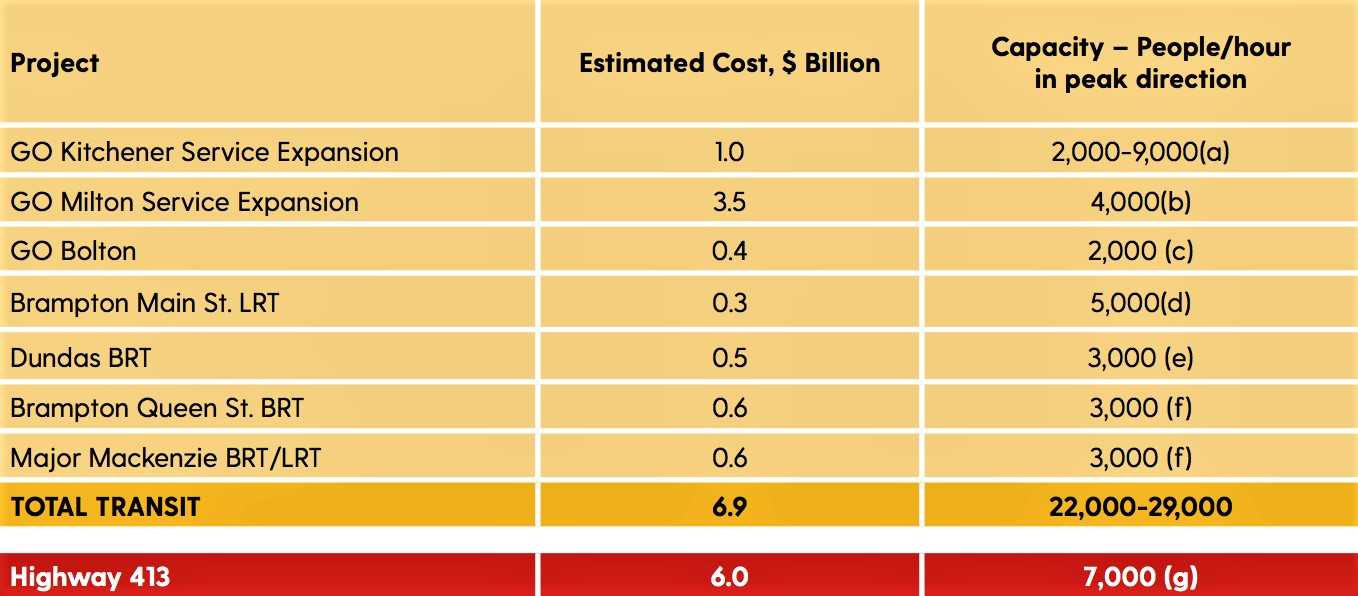
Environmental Defence says alternatives to the highway would be far more beneficial
The power to get the government to change its mind on this project lies with residents, Brooks said. If people make their case for why this project isn’t a good idea, the government might reconsider. “The people of Brampton don’t want it. We’ve talked to people in Kleinburg, who are now learning about the highway and don't want it. People in Halton don't want it. If nobody wants the highway, it probably shouldn't be built.”
The City of Brampton’s plan for the area where the 413 would run through the municipality’s western side dismisses the province’s highway design. Instead of the GTA West highway, also known as Highway 413, the city’s proposal is outlined in the recently approved staff design for the creation of Heritage Heights.
Dubbed as the last “undeveloped area” in the city, it makes up 17 square kilometers of Brampton’s land mass. If completed, Heritage Heights will house the largest portion of the estimated 300,000 new residents that will call Brampton home over the next 20 to 30 years.
Under the guidelines of Brampton’s 2040 Vision, the City’s approved master plan for future growth, the Heritage Heights concept approved August 5 by Council would include a central boulevard, instead of the highway, allowing for the integration of complete communities including residential dwellings and large commercial features alongside retail, dining and other employment opportunities. It’s envisioned as a “20-minute neighborhood,” allowing residents to accomplish most daily activities within a short walk from where they reside.
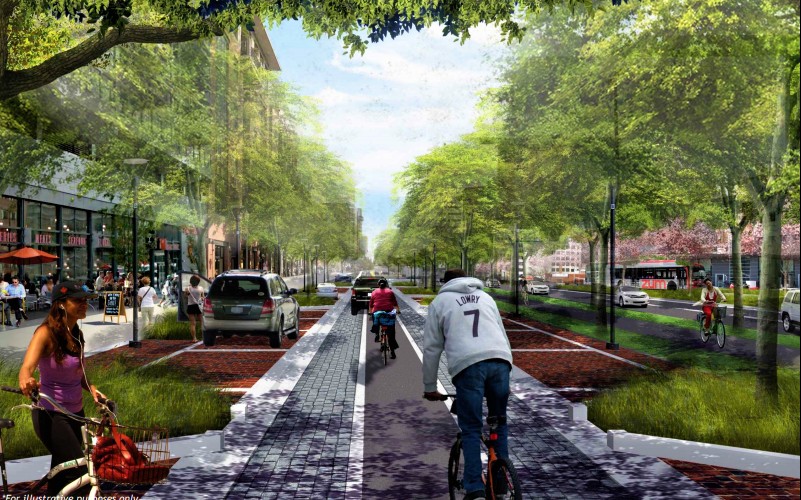
The Heritage Heights boulevard design, above, would replace the province's highway plan for the area
Instead of bisecting the entire area with a highway corridor whose roadway alone would be 170 metres wide, with hundreds of metres alongside for on and off ramps and other highway infrastructure features on either side, the boulevard would allow for pedestrian and bike use, mixed vehicular traffic and an integrated street design that would not act as a massive divider cutting off the east and west sides of the transportation corridor.
The provincial highway is not part of the city’s plan for the development, which would replace the GTA West Highway “with an urban boulevard running north-south through Heritage Heights,” the July staff report outlining the plan states.
The creation of the province’s Highway 413 will require a corridor that’s 50 kilometers long, passing through multiple cities and across the protected Greenbelt in Vaughan and right alongside it in Caledon. Its path through Brampton would cut through the middle of Heritage Heights, between Mississauga Road and Winston Churchill Boulevard.
Despite the potentially devastating impact on Caledon, its mayor, Allan Thompson, and most of his Council colleagues have aggressively pushed the highway including Jennifer Innis who is chair of the Toronto and Region Conservation Authority. Thompson sold family land right along the now approved highway route to a developer for $9.4 million.
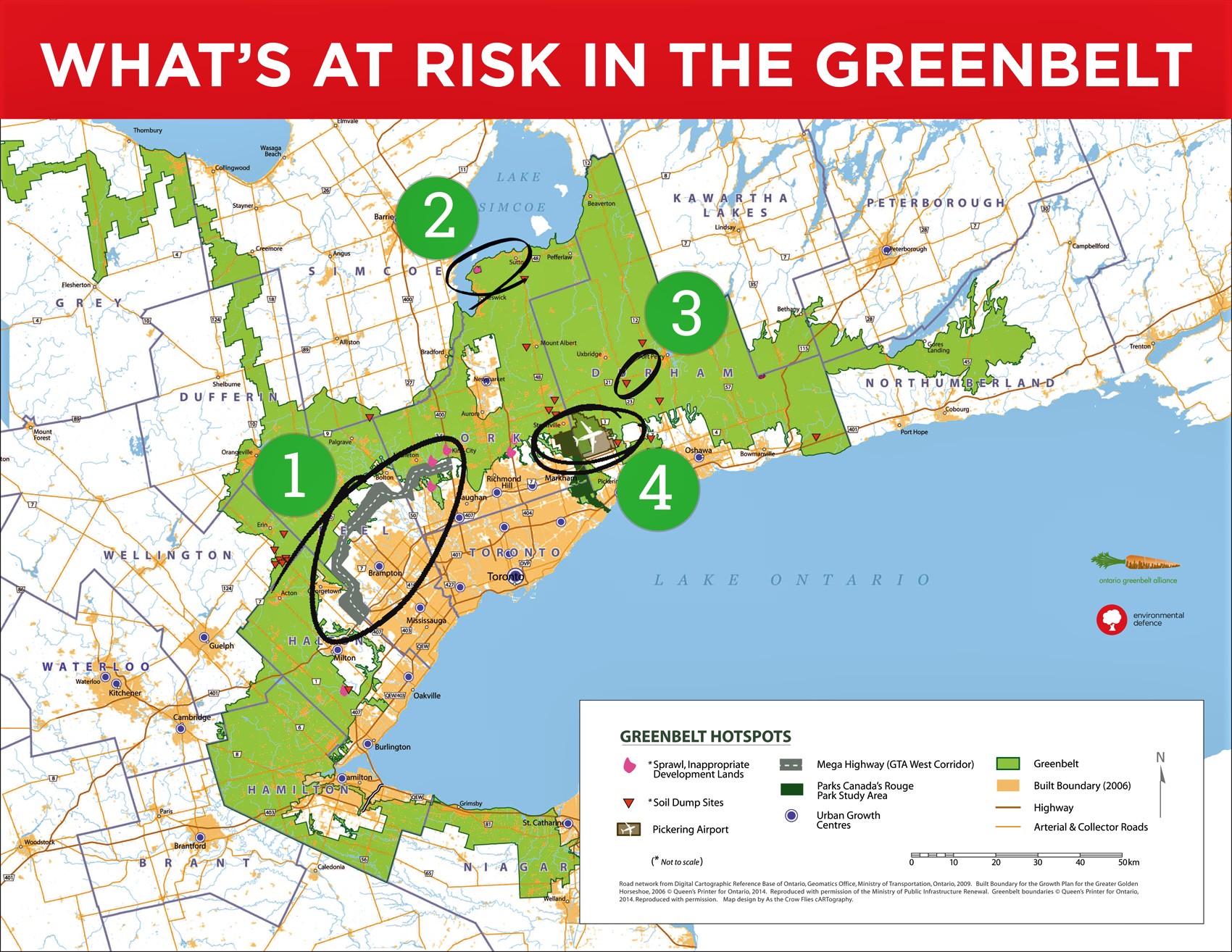
The GTA West Highway, circled above, is the largest risk to the Greenbelt
The Environmental Defence report also endorses the city’s approval of the boulevard. “Overall, it's... a more sustainable vision then a 400-series highway,” Brooks said.
The Pointer was told by the provincial transportation ministry that Brampton’s approved plan does not comply with provincial regulations. “Our preliminary review of the proposal put forward suggests that the proposed roadway design is not compatible with the Province’s functional and operational objective for the GTA West corridor,” the ministry told The Pointer on August 5, the day Brampton Council approved the Heritage Heights plan.
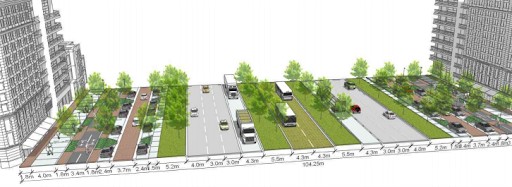
The City's boulevard design
The staff report asks council for permission to discuss the project with the province to pursue “infrastructure that contributes positively to the Heritage Heights community and not detract from it.”
In comments to The Pointer, responding to the province’s rejection of the boulevard design, staff stated provincial plans for the GTA West Highway reflect an approach that has not worked in the past, instead leading to “urban sprawl” and added “congestion”. “Since 2005, Brampton’s population has increased by more than 30 per cent and the city continues to be one of the most rapidly growing cities in Canada. It has been proven that the most effective approach to reducing congestion is to concentrate on smarter land use approaches. The Heritage Heights plan focuses on compact, mixed-use development adjacent to higher order transit, while at the same time creates a far more robust street network to spread vehicular trips, provide multiple routing options, and, overall, develop more livable and complete communities,” the City said.
Regional Councillor Martin Medeiros, the City’s chair of planning, has remained silent on the issue. The Pointer has reached out numerous times to learn why the boulevard was approved by council if it didn’t fall under provincial guidelines, but has yet to receive a response.
City of Brampton officials have been largely silent on the province’s push for the highway since the Doug Ford government came into power in 2018, while Council previously voted in favour of the province’s actions to restart the environmental assessment for the highway and put it back on the table after the Liberals scrapped the project shortly before the election.
During his election campaign Ford was captured in a leaked video telling a room full of developers that if elected he would open a large portion of the Greenbelt for them to build on. He openly campaigned on the creation of the GTA West Highway which was a prominent part of his platform.
The report from Environmental Defence says the creation of this highway will not decrease congestion, because of induced demand. Once a new highway is open to the public, it doesn't take long before an increase in traffic is seen. New infrastructure leads to a change in driving behaviour, with people driving more often, going longer distances and travelling at peak times because there is more space to do so, initially. In a few years, traffic ends up just as bad as it was before the highway was built. “Little is accomplished for traffic relief,” the report says. A quick scan of similar plans in the United States provides proof that highways do little to relieve congestion and improve travel times. For example, the Katy Freeway in Houston, Texas, had its lanes widened to 24 in 2008 to reduce traffic. Instead, traffic became even worse.
But the boulevard design will not happen if the province rejects it, as Queen’s Park has the ability to overrule municipal plans that are not compatible with its transportation objectives.
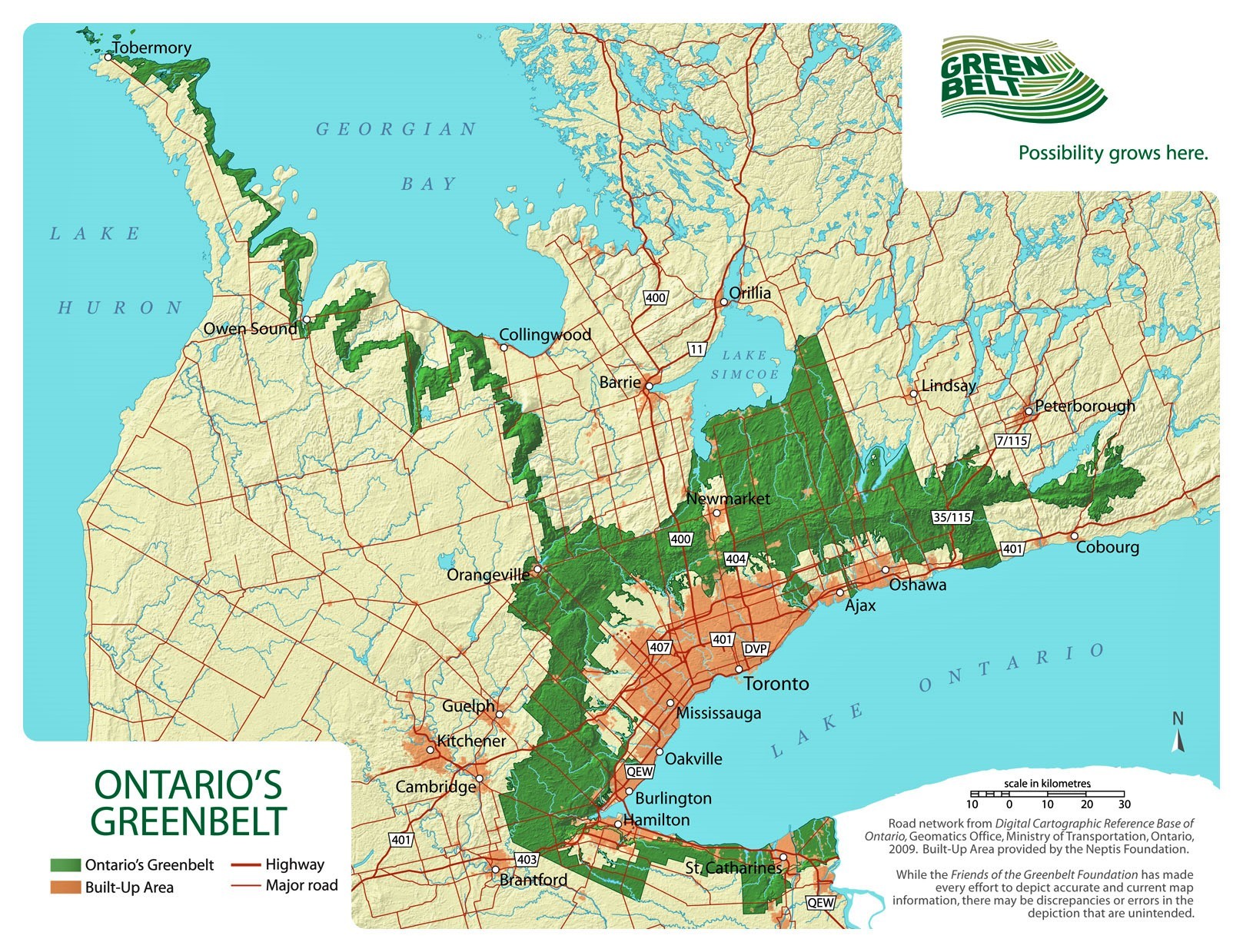
Urban sprawl has already encroached on the Greenbelt which is protected under provincial legislation
Instead of a new highway, the Environmental Defence report recommends a number of alternatives, including investing in public transit and widening existing highways where it makes sense. The current plan will be devastating for a number of portfolios – including “irreversible damage” to the environment; 33 percent of emissions in the Greater Toronto Area come from transportation, the report states, a number that will only increase when the highway is open to the public, during a time when the country is under a National Climate Emergency. It will also impact numerous rivers and wetlands, affecting the Credit River and Humber River, Brooks said. The loss of “1000 hectares in the Greenbelt in Vaughan” will also be seen, the report states. Another alternative to get more people out of their cars and onto public transportation is investment in projects such as GO Train & Bus services, the proposed Hurontario LRT extention, and the Brampton Queen Street corridor. The report shows such investments would lead to the efficient movement of 29,000 people an hour during peak times, compared to 7,000 people on Highway 413 during the same peak periods. The report estimates investment in the different streams of transportation would cost $6.9 billion.
Instead, the province’s plan will admittedly lead to large volumes of commercial truck use through Brampton to move goods through the region, along with single-occupancy vehicles that will hardly get any relief for commuters who will save only 30-60 seconds by using the 413 Highway.
Email: [email protected]
Twitter: @nida_zafar
Tel: 416 890-7643
COVID-19 is impacting all Canadians. At a time when vital public information is needed by everyone, The Pointer has taken down our paywall on all stories relating to the pandemic and those of public interest to ensure every resident of Brampton and Mississauga has access to the facts. For those who are able, we encourage you to consider a subscription. This will help us report on important public interest issues the community needs to know about now more than ever. You can register for a 30-day free trial HERE. Thereafter, The Pointer will charge $10 a month and you can cancel any time right on the website. Thank you.
Submit a correction about this story


